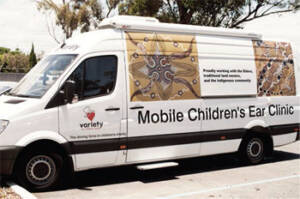The Ear Bus – Why do we need an Ear Bus?
Otitis Media is more common in late Autumn/Winter/early Spring months with records showing 1 in 3 children aged 1-8 years affected in these times. 20% of all preschoolers are affected by middle ear problems. Incidence of Otitis Media is much higher in aboriginal children. Records have shown as high as 80%. Until school age, an aboriginal child may experience a combined total of 2.5 years for all their episodes of Otitis Media. This means that they are a long way behind before they even start school.
 Poor behaviour is often misdiagnosed as ADHD when in fact it is directly related to middle ear problems. Hard to hear=hard to learn and behave.
Poor behaviour is often misdiagnosed as ADHD when in fact it is directly related to middle ear problems. Hard to hear=hard to learn and behave.
Antibiotics for middle ear problems are the most commonly prescribed medicine. Children often become immune to antibiotics after many episodes of Otitis Media, Grommet surgery for Otitis Media is the most common of all surgeries performed on children in Australia. Grommet is smaller than a match head and surgically inserted in the middle ear of a child to prevent recurrent ear infections. The vision for the Mobile Surgical Service is that of an innovative surgical ear health service to remote regions of Northern and Central Australia, achievable, practical and cost effective. The funding for the bus would be shared by the Health Department of Western Australia and the Commonwealth Department of Health, University of Western Australia (Medical Faculty), private industries like the mining companies operating in the region and Rotary. The Rotary District 9470 is supporting the Rotary Club of Como to launch a Global Grant under Future Vision in 2013. They are hoping to support this project with USD 100,000 and would like matching grant support from International partners. For Rotary contributions the Rotary wheel is proudly displayed on the bus with the wording “Proudly partly sponsored by Rotary”.
Outcomes of better hearing in children in the short term will be improved school attendance, increased self esteem, increased health and literacy skills. The long term results will be better integration into society of indigenous youth. Indigenous families will benefit through better hygiene, clean water and literacy.
